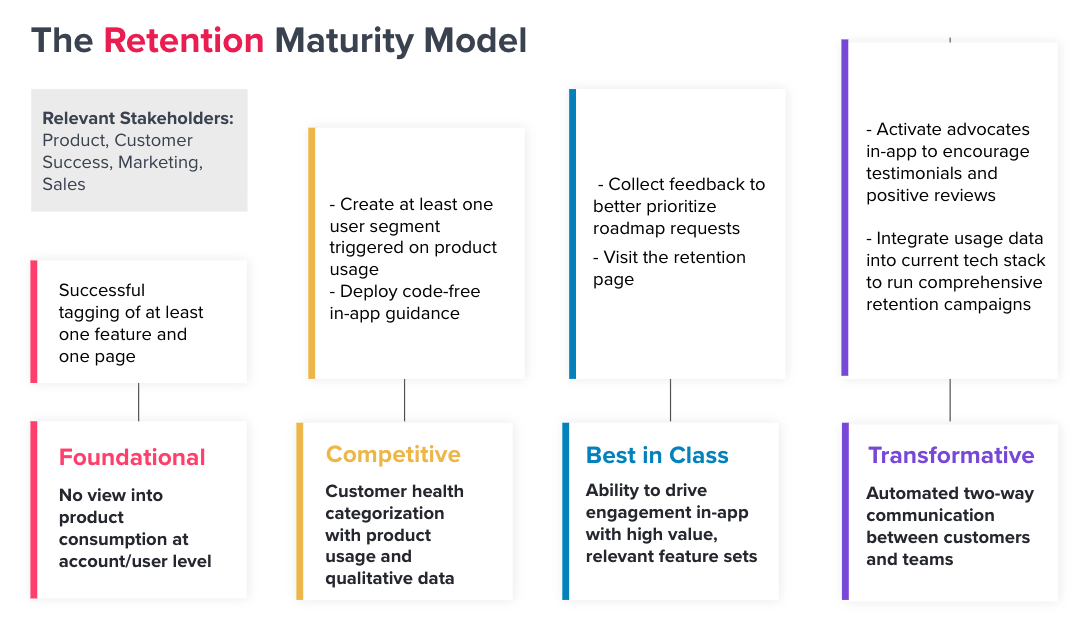Good customer success (CS) teams ensure high rates of customer retention. Great (read: product-led) success teams ensure their customers get value out of the product at every stage of their journey. This requires teams to define what the most valuable parts of their product are, align around it, measure it, and keep the CS organization laser-focused on helping unlock this value—driving not just retention, but growth.
As the director of data science at Pendo, I was presented with the challenge of leveraging our own product data to optimize our customer success team’s work. Right away, I asked myself two key questions: How can we help customer success managers (CSMs) better understand when their customers are or are not getting value out of Pendo? And how can we use data to enable CSMs to have strategic customer conversations without bogging them down with a series of reports and dashboards to sift through?
The answer? A maturity matrix.
What is a maturity matrix?
A maturity matrix is a simple score that classifies how mature a customer’s usage of a product is. It does this by aligning usage with a customer’s goal (i.e. what they bought the product to do) and then classifying usage on a scale from foundational to transformative. Contextualizing usage around the guardrails of goals allows teams to take the universe of feature usage data and turn it into a measurement of value.
Below, I walk through how we built a maturity matrix to identify good and suboptimal uses of Pendo at scale, and discuss how we empowered our customer success team to use it effectively.
Step 1: Understand your product’s value proposition
The first step is to align around your product’s value. What problems does your product aim to solve? How does your sales team position your product, and what do your champions say the product helps them achieve? At Pendo, our suite of products helps customers solve for five main challenges that align to various parts of their product journey:

In our case, if a customer is using Pendo to solve one of these challenges, are they doing it effectively and seeing positive outcomes? Customer success teams often ask their customers to answer the second half of this question. Business reviews or success plans are centered around asking customers for data on the outcomes they achieved—did their retention rates improve? Did they deflect tickets? Did they significantly decrease their onboarding time?
While these are all important outcomes, they are not scalable metrics that CS teams (and the analysts or data scientists who support them) can use to measure value. A CSM would need to ask each individual customer and collect this data in a systematic way, and customers would need to be willing and able to provide the information in the first place. It just doesn’t scale. Data analysts, on the other hand, are often tasked with answering this question, but lack the theoretical basis to understand how the product was designed. So they spend hours sifting through data only to find things that are either very obvious or not very meaningful.
To understand whether or not a customer is realizing value from your product, you need to understand if they are using the features that were designed to solve their problems. This is the hard part. It will likely involve product managers, designers, product operations, customer success, value consultants, and conversations with your customers. But if done well, you can arrive at what is essentially a list of features aligned to various jobs to be done, ordered by increasing complexity. At Pendo, we call this our maturity matrix.
Step 2: Build your maturity matrix
Start by determining which parts of your product align to your key use cases identified in step one, and order them by complexity. This needs to be a consensus-driven process (we’ll get to the data soon!), and will likely be driven in close partnership with the product team.
At this stage, you don’t have to go into the weeds of individual features, but think at a high level: what does really good usage of your product look like? This will require talking to your product and design teams, your sales and value teams, and also your most loyal customers, advocates, and power users. What do they love about your product, and how does it help them do their jobs better? Rank these features or product areas in order from the least to most complex, which will help you build a natural maturity progression.
As an example, here’s what we landed on for our Retention use case:

Once you have a rough matrix that passes your gut check, use Pendo to tag those features and start digging into the data for each item in the matrix. For example, to measure whether customers “Deploy code-free in-app guidance,” we use a field that identifies when a customer has launched at least one public guide to production. Our analytics team used data from our API to create a series of if/then statements (based on actions in the product) that then constitute a maturity score. On any given day, we can classify our customers’ usage of Pendo as foundational, competitive, best-in-class, or transformative. This is their maturity score.
Step 3: Correlate maturity scores to an external outcome
Next, it’s helpful to examine if customers with a higher maturity score tend to have better outcomes. CSMs won’t know a customer’s own outcomes or financial metrics at scale, but they can identify if your customers continued to use your product, renewed their subscriptions, or expanded. This helps you understand if customers who achieve value out of your product also tend to be happier, stick around for longer, and grow.
At Pendo, we looked at a history of maturity scores for the past year and assessed if customers who expanded had a higher maturity score than those who didn’t expand. Across the board, we saw that customers who showed growth in their maturity scores (meaning, they grew over time to start using more high-value parts of Pendo) expanded more—and churned less—than those who remained at the same level of maturity.
To us, this indicates that our maturity score provides some predictability and is worth aligning on as a north star metric. Because it aligns to a customer’s own use case (which we collect when they first become a customer), the maturity score proves to be much more targeted and accurate compared to high-level metrics like retention, or even simply using the same features to measure value across the board. In other words, it’s personalized to the problems our customers want to solve.
Step 4: Put your maturity score to work
Once you have a maturity score for each customer, here are some ideas for how stakeholders across the company can leverage it:
Pendo administrators:
If you notice certain features are used to measure maturity across multiple or all use cases, these might be universally valuable parts of your product. Setting these up as Core Events will allow your CSMs to track product engagement score (PES) for their customers and understand what influences each pillar of their score, helping them drive a strategic roadmap for usage that is aligned to value.
Customer success leaders:
Identify customers who are still at a foundational use of your product 90 days in (this could be a KPI that your team measures against). If more than 20% of your customers are in this bucket at the 90-day mark, your product onboarding flows might need work. Consider using Guide Experiments with some of your value-driving features as outcomes to see if you can improve how you deliver value early in a user’s journey.
Customer success managers:
Be direct and transparent about your customers’ maturity scores. Use it as a tool and framework for conversations with your customers around their usage of your product. Strategically discuss how to advance them to higher levels of maturity, for example by providing success stories from customers with a similar use case who have gotten value out of higher-level features.
Onboarding specialists:
Perhaps you want to measure the outcomes of your professional services onboarding offering. Use the maturity score as a goal for this initiative—for example, you could aim for a significant portion of your customers to get to a foundational level within their first X days of purchasing your product. In cases where they have not, dig into why—their pain points might illuminate parts of your product that are difficult to use, or which may require in-app guidance to assist them along the way.
Product and UX teams:
Launch in-app guides for customers who are at the threshold of a new phase of maturity, reminding them of the value of the next feature in the matrix and why it aligns with their own priorities. Also consider doing qualitative research (e.g. with in-app surveys) from segments of customers that you’d like to see adopt features in a higher band of maturity, but who haven’t yet done so.This might illuminate areas of your product that require simplification. For example, we did a UX audit for our Segments feature (a highly valuable feature that wasn’t seeing adoption as early as we wanted) and identified areas of improvement, which we’ve been rolling out in the past year.
Aligning tagged features in Pendo with your key use cases and ordering them by maturity provides a clear framework for customer success teams to measure customer value. If you have an analytics team, encourage them to partner with CS to roll out a maturity or value score. This close collaboration will help your success teams become more product led, ensure your customers attain value faster (and with less resource-intensive human intervention), and improve customer and business outcomes across the board.


